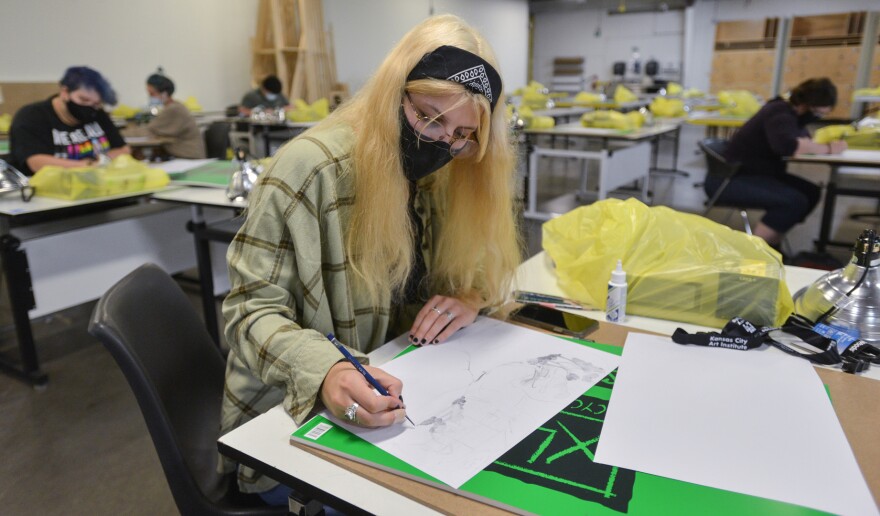Fall classes at the Kansas City Art Institute resumed on August 31. And this year, that means face masks, social distancing, daily symptom checks — and a reckoning with the institution's role in dismantling white supremacy.
That last item, according to the school's president Tony Jones, "is actually not a new issue. It’s had more of a spotlight thrown on it.”
Jones joined KCAI in 2014, and he spent months with staff and faculty preparing for the fall semester, mapping out traffic flow in buildings, and re-configuring classrooms. Nonetheless, he calls the first day back on campus "a complete bloody disaster."
“There was a huge rainstorm,” he says. “We lost power in the buildings. No one was able to work.”
And there was already plenty to worry about without a power outage. KCAI begins this semester in hybrid mode, with liberal arts and art history classes offered online, but studio classes still happening in-person.
After all, students go to art school to make things.
“That's what students want,” Jones explains. “They want that personal interaction with a faculty member in a studio with equipment and tools and machinery.”
Back in the Spring, when campus shut down, that access to art-making tools disappeared. Students started cobbling together studio spaces on the spot.
“So, everything from spare bedrooms to basements to somebody was in an RV that they turned into a studio,” Jones says. “Any space that you could find to be able to make the work come to life.”
That pivot is currently on full display inside the H&R Block Artspace. The annual BFA exhibition is usually paired with commencement as part of celebrating the students' accomplishments as artists. This year, it was postponed, so recent graduates are just now exhibiting their work.
Michael Schonhoff, who directs the new on-campus KCAI Gallery, says that students living in other cities had to improvise to complete their artwork or install it, with on-site help from friends here in town.
"The artist, who would be in Florida or Minnesota or California, was on FaceTime in the room, on the phone, talking to individuals," he explains. "How to place it, where to put it. And that was kind of extraordinary.”
That type of flexibility and ingenuity continues on campus this fall.
“We're kind of taking a deep breath and saying, 'Okay, here we go,'" says Jim Woodfill, an interdisciplinary artist and professor of painting.
“So far we've been so happy with the positive response from the students that are willing to take on all the extra rules and the mask-wearing and social distancing to kind of get back to work," he says.
Morgan Reiker, a senior in painting, wasn't sure how students would interact and critique each other's work in a socially distanced studio. She's been pleasantly surprised.
"We're shouting back and forth across the studios and still finding ways to be in each other's business,” she says. “Even if it's through a Zoom call right next to each other.”
But the coronavirus isn't the only thing bringing change to the Kansas City Art Institute. Students across the country are asking for concrete steps toward racial justice, and this art school is no exception.
“We started working on this list of demands way before George Floyd, way before all of the protests,” says Jada Patterson, who graduated from the Art Institute in May.
Patterson is part of a team of students from KCAI’s Student Solidarity Network and the Black Student Union, who — together — submitted 14 demands to the administration in July.
Patterson says the students conducted research and did surveys to create the list, which included incorporating global studies into liberal arts and art history classes and hiring and retaining more tenure-track faculty who are Black, Indigenous, or people of color (BIPOC).
“All the faculty that are in departments are required to be practicing artists,” Patterson explains. “So when you are not seeing that in the school, you are not seeing yourself represented.”
That's also a top priority for London Williams, a senior. “Although I’ve had amazing professors at the Art Institute and I’ve had great experiences, I feel as though there’s a connection that lacks there because of cultural differences,” he says. “I wish I would have had more mentors of color at the Art Institute.”
In August, the Art Institute submitted an 18-page response to the students' demands.
President Tony Jones says the school has taken immediate steps and created an action plan. But he knows there’s still lots of work ahead.
“There's an incredible willingness on everybody's part to be a partner in that discussion and make that work,” Jones says.
Just like it will take the work of staff, faculty and students to keep the campus safe during the pandemic as health and city officials warn the metro area could soon become a hotspot for COVID-19.
Copyright 2021 KCUR 89.3. To see more, visit KCUR 89.3. 9(MDA3OTgyNDI4MDEzMTM0MjQzMTZlNDI0Mg004))





